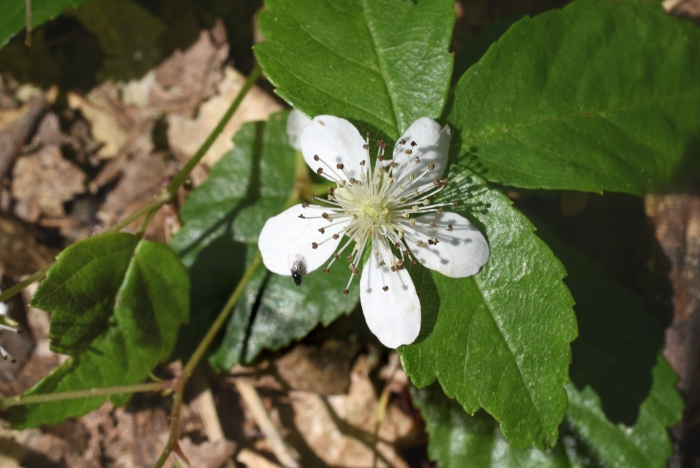Swamp Dewberry
(Rubus hispidus)
Swamp Dewberry (Rubus hispidus)
/
/

davecz2
CC BY-SA 4.0
Image By:
davecz2
Recorded By:
Copyright:
CC BY-SA 4.0
Copyright Notice:
Photo by: davecz2 | License Type: CC BY-SA 4.0 | License URL: http://creativecommons.org/licenses/by-sa/4.0/ | Rights Holder: davecz2 | Publisher: iNaturalist | Date Created: 2017-06-27T08:22:37-07:00 |













Estimated Native Range
Summary
Rubus hispidus, commonly known as Swamp Dewberry, is a low-growing, perennial herb-like shrub native to wetland margins, bogs, and moist woodlands in central and eastern North America, from Ontario and Minnesota east to Newfoundland and south to South Carolina and Mississippi. It typically reaches up to 8 inches tall and spreads via rhizomes to form dense mats. The plant features red bristly twigs and produces clusters of five-petaled white flowers in late spring to early summer, followed by small red to purple berries that are attractive to wildlife.
Swamp Dewberry is valued for its wildlife benefits and its ability to stabilize soil in wet areas. It is often used for naturalizing in moist garden areas, as ground cover, and in restoration projects. This plant prefers partial shade to full sun, consistently moist soils, and does not tolerate drought well. While it is generally low-maintenance, it can become aggressive in favorable conditions. Gardeners should be cautious of its potential to spread and consider containment measures if necessary.CC BY-SA 4.0
Swamp Dewberry is valued for its wildlife benefits and its ability to stabilize soil in wet areas. It is often used for naturalizing in moist garden areas, as ground cover, and in restoration projects. This plant prefers partial shade to full sun, consistently moist soils, and does not tolerate drought well. While it is generally low-maintenance, it can become aggressive in favorable conditions. Gardeners should be cautious of its potential to spread and consider containment measures if necessary.CC BY-SA 4.0
Plant Description
- Plant Type: Shrub
- Height: 0.5-1.5 feet
- Width: 2-5 feet
- Growth Rate: Slow, Moderate
- Flower Color: White
- Flowering Season: Spring, Summer, Fall
- Leaf Retention: Deciduous
Growth Requirements
- Sun: Full Sun, Part Shade
- Water: High
- Drainage: Fast, Medium, Slow
Common Uses
Bee Garden, Bird Garden, Erosion Control, Low Maintenance, Water Garden
Natural Habitat
Wetland margins, bogs, and moist woodlands
Other Names
Common Names: Swamp Dewberry, Running Swamp Blackberry, Running Blackberry, Swamp Blackberry, Hispid Blackberry, Bristly Blackberry
Scientific Names: , Rubus hispidus, Rubus hispidus f. pleniflorus, Rubus hispidus var. cupulifer, Rubus hispidus var. hispidus, Rubus hispidus var. major, Rubus hispidus var. obovalis, Rubus hispidus var. pervarius, Rubus hispidus var. vigil, Rubus obovalis
GBIF Accepted Name: